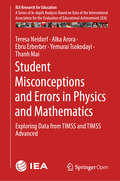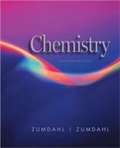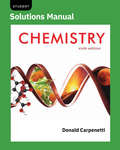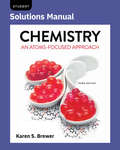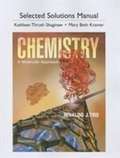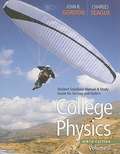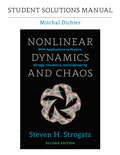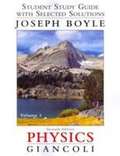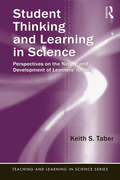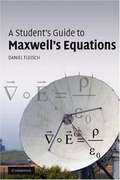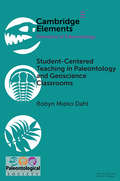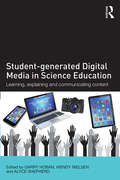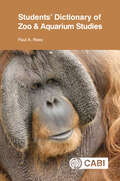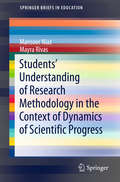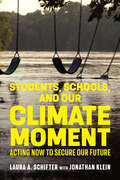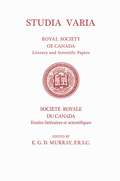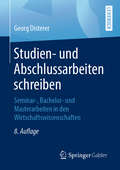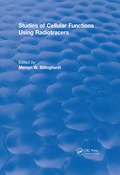- Table View
- List View
Student Journal Yesterday Today and Tomorrow - 6ES2
by Battle Creek Area Mathematics and Science CenterA Sixth Grade Unit supporting the Michigan Science K-7 Content Expectations
Student Lab Manual for Argument-driven Inquiry in Physical Science: Lab Investigations for Grades 6-8
by Patrick Enderle Victor Sampson Jonathon Grooms Todd Hutner Ashley MurphyAre you interested in using argument-driven inquiry for middle school lab instruction but just aren’t sure how to do it? Argument-Driven Inquiry in Physical Science will provide you with both the information and instructional materials you need to start using this method right away. The book is a one-stop source of expertise, advice, and investigations to help physical science students work the way scientists do. Student Lab Manual for Argument-Driven Inquiry in Life Science provides the student materials you need to guide your students through these investigations. With lab details, student handouts, and safety information, your students will be ready to start investigating.
Student Misconceptions and Errors in Physics and Mathematics: Exploring Data from TIMSS and TIMSS Advanced (IEA Research for Education #9)
by Teresa Neidorf Alka Arora Ebru Erberber Yemurai Tsokodayi Thanh MaiThis open access report explores the nature and extent of students’ misconceptions and misunderstandings related to core concepts in physics and mathematics and physics across grades four, eight and 12. Twenty years of data from the IEA’s Trends in International Mathematics and Science Study (TIMSS) and TIMSS Advanced assessments are analyzed, specifically for five countries (Italy, Norway, Russian Federation, Slovenia, and the United States) who participated in all or almost all TIMSS and TIMSS Advanced assessments between 1995 and 2015.The report focuses on students’ understandings related to gravitational force in physics and linear equations in mathematics. It identifies some specific misconceptions, errors, and misunderstandings demonstrated by the TIMSS Advanced grade 12 students for these core concepts, and shows how these can be traced back to poor foundational development of these concepts in earlier grades. Patterns in misconceptions and misunderstandings are reported by grade, country, and gender. In addition, specific misconceptions and misunderstandings are tracked over time, using trend items administered in multiple assessment cycles. The study and associated methodology may enable education systems to help identify specific needs in the curriculum, improve inform instruction across grades and also raise possibilities for future TIMSS assessment design and reporting that may provide more diagnostic outcomes.
Student Notebook, Middle School Life Science (STEMscopes™ CA-NGSS 3D)
by Rice University Inc. Accelerate LearningNIMAC-sourced textbook
Student Notebook, Middle School Physical Science (STEMscopes™ CA-NGSS 3D)
by Rice University Inc. Accelerate LearningNIMAC-sourced textbook
Student Science Workbook McGraw Hill: States of Matter, Chapter Resources for Differentiated Instruction
by McGraw HillNIMAC-sourced textbook
Student Solution Manual for Essential Mathematical Methods for the Physical Sciences
by M. P. Hobson K. F. RileyThis Student Solution Manual provides complete solutions to all the odd-numbered problems in Essential Mathematical Methods for the Physical Sciences. It takes students through each problem step-by-step, so they can clearly see how the solution is reached, and understand any mistakes in their own working. Students will learn by example how to select an appropriate method, improving their problem-solving skills.
Student Solutions Guide to Accompany Chemistry
by Thomas J. Hummel Steve S. Zumdahl Susan Arena ZumdahlProvides carefully worked out, complete solutions for all odd-numbered questions and exercises in the text. Uses the same solutions methods as examples in the text.
Student Solutions Manual (Sixth Edition): For Chemistry
by Thomas R. Gilbert Rein V. Kirss Natalie Foster Stacey Lowery BretzThe Student Solutions Manual contains detailed, fully worked solutions to all even-numbered EOC problems using the COAST (Collect and Organize, Analyze, Solve, and Think About It) problem solving format.
Student Solutions Manual (Third Edition): For Chemistry: An Atoms-focused Approach
by Thomas R. Gilbert Rein V. Kirss Natalie Foster Stacey Lowery BretzA research-based, atoms-focused text that helps students visualize chemistry as they solve problems. The Student Solutions Manual contains detailed, fully worked solutions to all even-numbered EOC problems using the COAST (Collect and Organize, Analyze, Solve, and Think About It) problem solving format. This purchase offers access to the digital ebook only.
Student Solutions Manual For Chemistry: A Molecular Approach
by Nivaldo J. Tro Kathy Thrush Shaginaw Mary Beth KramerThe selected solution manual for students contains complete, step-by-step solutions to selected odd-numbered end-of-chapter problems.
Student Solutions Manual and Study Guide for College Physics 9th Edition Volume 2
by Charles Teague John R. Gordon Raymond SerwayFor Chapters 15-30, this manual contains detailed solutions to approximately twelve problems per chapter. These problems are indicated in the textbook with boxed problem numbers. The manual also features a skills section, important notes from key sections of the text, and a list of important equations and concepts.
Student Solutions Manual for Kotz and Treichel's Chemistry and Chemical Reactivity 5th edition
by Alton J. Banksnone.
Student Solutions Manual for Nonlinear Dynamics and Chaos, 2nd edition
by Mitchal DichterThis official Student Solutions Manual includes solutions to the odd-numbered exercises featured in the second edition of Steven Strogatz's classic text Nonlinear Dynamics and Chaos: With Applications to Physics, Biology, Chemistry, and Engineering. The textbook and accompanying Student Solutions Manual are aimed at newcomers to nonlinear dynamics and chaos, especially students taking a first course in the subject. Complete with graphs and worked-out solutions, this manual demonstrates techniques for students to analyze differential equations, bifurcations, chaos, fractals, and other subjects Strogatz explores in his popular book.
Student Study Guide And Selected Solutions Manual For Physics: Principles With Applications, Volume 1
by Douglas C. Giancoli Joe BoyleThis Study Guide complements the strong pedagogy in Giancoli's text with overviews, topic summaries and exercises, key phrases and terms, self-study exams, problems for review of each chapter, and answers and solutions to selected EOC material.
Student Thinking and Learning in Science: Perspectives on the Nature and Development of Learners' Ideas (Teaching and Learning in Science Series)
by Keith S. TaberThis readable and informative survey of key ideas about students’ thinking in science builds a bridge between theory and practice by offering clear accounts from research, and showing how they relate to actual examples of students talking about widely taught science topics. Focused on secondary students and drawing on perspectives found in the international research literature, the goal is not to offer a comprehensive account of the vast literature, but rather to provide an overview of the current state of the field suitable for those who need an understanding of core thinking about learners’ ideas in science, including science education students in teacher preparation and higher degree programs, and classroom teachers, especially those working with middle school, high school, or college level students. Such understanding can inform and enrich science teaching in ways which are more satisfying for teachers, less confusing and frustrating for learners, and so ultimately can lead to both greater scientific literacy and more positive attitudes to science.
Student's Guide to Maxwell's Equations
by Daniel FleischGauss's law for electric fields, Gauss's law for magnetic fields, Faraday's law, and the Ampere-Maxwell law are four of the most influential equations in science. In this guide for students, each equation is the subject of an entire chapter, with detailed, plain-language explanations of the physical meaning of each symbol in the equation, for both the integral and differential forms. The final chapter shows how Maxwell's equations may be combined to produce the wave equation, the basis for the electromagnetic theory of light. This book is a wonderful resource for undergraduate and graduate courses in electromagnetism and electromagnetics. A website hosted by the author at www. cambridge. org/9780521701471 contains interactive solutions to every problem in the text as well as audio podcasts to walk students through each chapter.
Student-Centered Teaching in Paleontology and Geoscience Classrooms (Elements of Paleontology)
by Robyn Mieko DahlResearch on learning and cognition in geoscience education research and other discipline-based education communities suggests that effective instruction should include three key components: a) activation of students' prior knowledge on the subject, b) an active learning pedagogy that allows students to address any existing misconceptions and then build a new understanding of the concept, and c) metacognitive reflections that require students to evaluate their own learning processes during the lesson. This Element provides an overview of the research on student-centered pedagogy in introductory geoscience and paleontology courses and gives examples of these instructional approaches. Student-centered learning shifts the power and attention in a classroom from the instructor to the students. In a student-centered classroom, students are in control of their learning experience and the instructor functions primarily as a guide. Student-centered classrooms trade traditional lecture for conceptually-oriented tasks, collaborative learning activities, new technology, inquiry-based learning, and metacognitive reflection.
Student-generated Digital Media in Science Education: Learning, explaining and communicating content
by Garry Hoban Wendy Nielsen Alyce Shepherd"This timely and innovative book encourages us to ‘flip the classroom’ and empower our students to become content creators. Through creating digital media, they will not only improve their communication skills, but also gain a deeper understanding of core scientific concepts. This book will inspire science academics and science teacher educators to design learning experiences that allow students to take control of their own learning, to generate media that will stimulate them to engage with, learn about, and become effective communicators of science." Professors Susan Jones and Brian F. Yates, Australian Learning and Teaching Council Discipline Scholars for Science "Represents a giant leap forward in our understanding of how digital media can enrich not only the learning of science but also the professional learning of science teachers." Professor Tom Russell, Queen’s University, Ontario, Canada "This excellent edited collection brings together authors at the forefront of promoting media creation in science by children and young people. New media of all kinds are the most culturally significant forms in the lives of learners and the work in this book shows how they can move between home and school and provide new contexts for learning as well as an understanding of key concepts." Dr John Potter, London Knowledge Lab, Dept. of Culture, Communication and Media, University College London, UK Student-generated Digital Media in Science Education supports secondary school teachers, lecturers in universities and teacher educators in improving engagement and understanding in science by helping students unleash their enthusiasm for creating media within the science classroom. Written by pioneers who have been developing their ideas in students’ media making over the last 10 years, it provides a theoretical background, case studies, and a wide range of assignments and assessment tasks designed to address the vital issue of disengagement amongst science learners. It showcases opportunities for learners to use the tools that they already own to design, make and explain science content with five digital media forms that build upon each other— podcasts, digital stories, slowmation, video and blended media. Each chapter provides advice for implementation and evidence of engagement as learners use digital tools to learn science content, develop communication skills, and create science explanations. A student team’s music video animation of the Krebs cycle, a podcast on chemical reactions presented as commentary on a boxing match, a wiki page on an entry in the periodic table of elements, and an animation on vitamin D deficiency among hijab-wearing Muslim women are just some of the imaginative assignments demonstrated. Student-generated Digital Media in Science Education illuminates innovative ways to engage science learners with science content using contemporary digital technologies. It is a must-read text for all educators keen to effectively convey the excitement and wonder of science in the 21st century.
Students' Dictionary of Zoo and Aquarium Studies
by Dr Paul ReesThis Students' Dictionary of Zoo and Aquarium Studies contains over 5,000 terms (illustrated by 88 figures) used in zoos, aquariums, safari parks, birds of prey centres, petting zoos, animal rescue centres and other facilities that make up the 'zoo industry'. It covers a wide range of topics including animal behaviour, animal husbandry, animal welfare, ecology, law, taxonomy, classification, nutrition, parasitology, physiology, reproduction, experimental design, statistics, veterinary science, disease, visitor studies, water management, wildlife conservation and zoo design and architecture. It should be of great interest to those studying zoo biology, animal management, veterinary science and related subjects along with zookeepers and aquarists in the early stages of their careers. Dr Paul Rees has a long-standing interest in animals and in zoos. He has taught a wide range of subjects including ecology, animal behaviour, zoo biology, and wildlife and zoo law. While lecturing at the University of Salford he created the first undergraduate programme in Wildlife Conservation and Zoo Biology in the United Kingdom and over a period of some 20 years was an external examiner for BSc and MSc programmes in zoo biology and wildlife conservation at the Universities of Edinburgh, Chester, Staffordshire, Wolverhampton, Gloucestershire and Nottingham Trent University. Dr Rees has published research on the large mammal fauna of Ngorongoro Crater, Tanzania, the ecology and behaviour of elephants and cheetahs living in zoos, and the laws concerning wildlife reintroductions and the regulation of zoos.
Students' Understanding of Research Methodology in the Context of Dynamics of Scientific Progress
by Mansoor Niaz Mayra RivasThis book discusses how to improve high school students'understanding of research methodology based on alternative interpretations of data, role of controversies, creativity andthe scientific method, in the context of the oil drop experiment. These aspects form an important part of thenature of science (NOS). The study reported in this volume is is based on a reflective, explicit and activity-based approach to teachingnature of science (NOS) that can facilitate high school students' understanding of how scientists elaborate theoreticalframeworks, design experiments, report data that leads to controversies and finally with thecollaboration of the scientific community a consensus is reached. Most students changed their perspective and drew concept maps in whichthey emphasized the creative, accumulative, controversialnature of science and the scientific method.
Students, Schools, and Our Climate Moment: Acting Now to Secure Our Future
by Laura A. Schifter Jonathan KleinA call to action that promotes K–12 schools and students as key contributors to climate solutions
Studia Varia: (Royal Society of Canada, Literary and Scientific Papers) (The Royal Society of Canada Special Publications #No. 2)
by E.G.D. MurrayTHIS VOLUME contains a selection of articles by Fellows of the Royal Society of Canada on subjects of general cultural interest. The majority of the papers were presented at the annual meeting of the Society in 1956, but for the first time in the history of the Society, they are being issued in a volume available to the general public, instead of being restricted to the Society's Transactions. It has long been a cause for regret to many who were aware of the stimulating and authoritative nature of many Royal Society papers on generalized topics that they were not readily available to the general reader. This volume is an effort on the part of the Society to broaden its influence, to share with educated readers everywhere the contributions which its Fellows make to literary and scientific thought.Authors and articles are as follows: Pierre Daviault, "Franҫais et anglais du Canada"; Desmond Pacey, "The Canadian writer and his public, 1882-1952"; Northrop Frye, "Preface to an uncollected anthology"; Jacques Rousseau, "L'Indien de la forêt boréale, élément de la formation écologique"; W. H. Watson, "Perspective towards the future in physics"; Vincent Bladen, "Some reflection on the classical literature of political economy"; T. A. Goudge, "Progress and evolution"; J. S. Thomson, "The existential philosophy"; Pierre Dansereau, "Language, communication, and culture"; Henry Alexander, "Breaking the language barrier"; Jean-Charles Falardeau, "L'Importance des langues secondes et les sciences de l'homme."
Studien- und Abschlussarbeiten schreiben: Seminar-, Bachelor- und Masterarbeiten in den Wirtschaftswissenschaften (Springer-Lehrbuch)
by Georg DistererDieses Buch hilft Studierenden der Wirtschafts- und Sozialwissenschaften, Studienarbeiten aller Art erfolgreich zu schreiben, also etwa Hausarbeiten und Seminararbeiten sowie Abschlussarbeiten wie Bachelorarbeiten und Masterarbeiten. Detailliert werden die inhaltlichen und formalen Anforderungen an Studienarbeiten beschrieben und die Gründe für formale Regularien in Prüfungsordnungen und Zitierrichtlinien erläutert. Das Buch bietet einen anschaulichen Leitfaden und gibt konkrete Unterstützung in einer prägnanten und verständlichen Darstellung. Die Anforderungen an Studienarbeiten werden auf diese Weise transparent und klar. Durch die im Buch enthaltenen anschaulichen und nützlichen Handlungsanleitungen wird das Anfertigen von Studienarbeiten zu einer interessanten und spannenden Aufgabe.
Studies Of Cellular Functions Using Radiotracers (CRC Press Revivals)
by Mervyn W BillinghurstThis volume is the result of the concerted effeort of a number os scientists to summarize in a succinct way the current understanding of the mechanisms of these localizations. The editors of the book gratefully acknowledge this combined effort.


